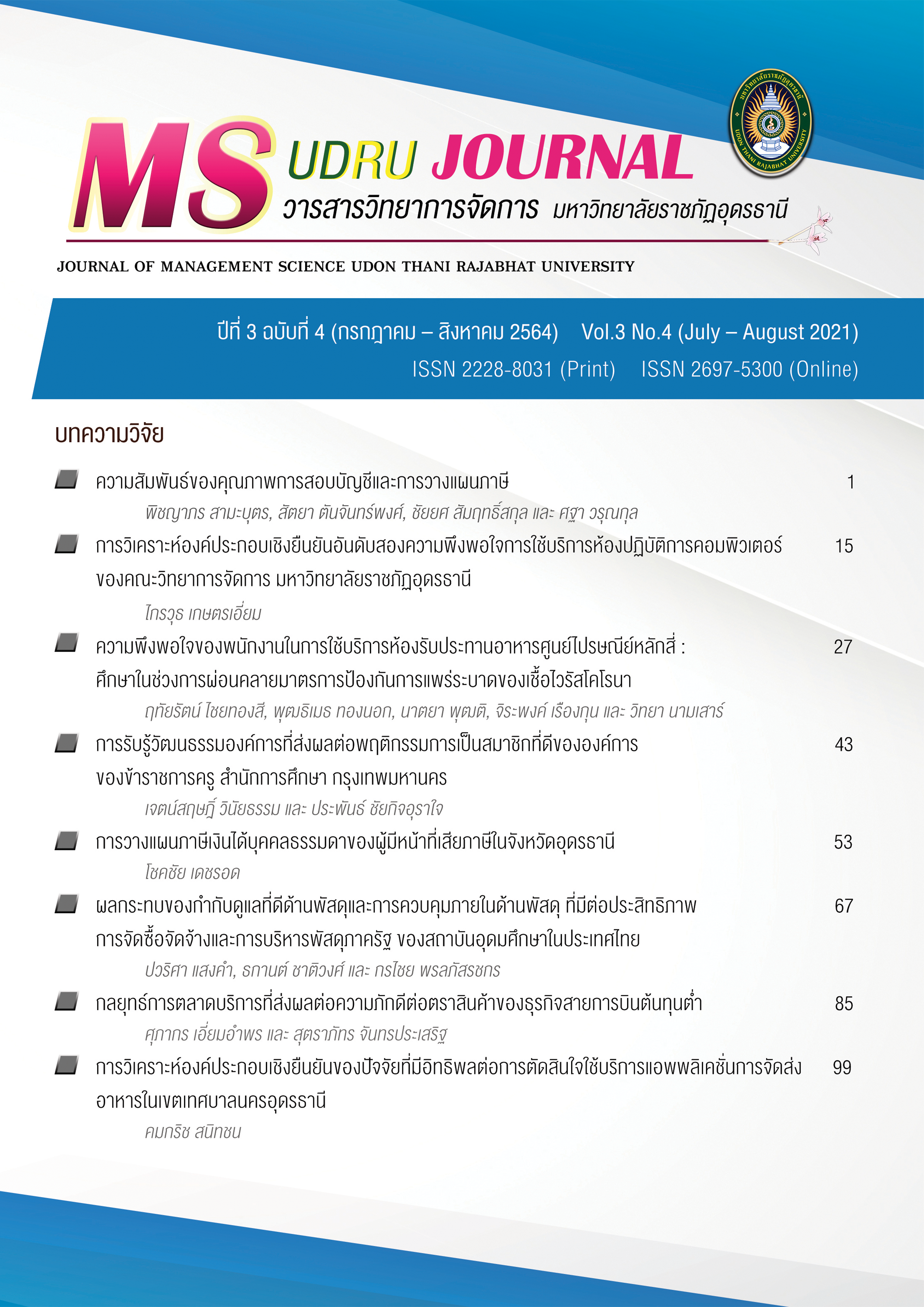ความพึงพอใจของพนักงานในการใช้บริการห้องรับประทานอาหารศูนย์ไปรษณีย์หลักสี่: ศึกษาในช่วงการผ่อนคลายมาตรการป้องกันการแพร่ระบาดของเชื้อไวรัสโคโรนา
Main Article Content
บทคัดย่อ
การวิจัยมีวัตถุประสงค์เพื่อ 1) ศึกษาระดับความพึงพอใจของพนักงานในการใช้บริการห้องรับประทานอาหารศูนย์ไปรษณีย์หลักสี่ ในช่วงการผ่อนคลายมาตรการป้องกันการแพร่ระบาดของเชื้อไวรัสโคโรนา และ 2) เปรียบเทียบความพึงพอใจของพนักงานในการใช้บริการห้องรับประทานอาหารศูนย์ไปรษณีย์หลักสี่ ในช่วงการผ่อนคลายมาตรการป้องกันการแพร่ระบาดของเชื้อไวรัสโคโรนา จำแนกตามเพศ อายุ ประเภทบุคลากร และรายได้ต่อเดือน โดยใช้การวิจัยเชิงปริมาณ รวบรวมข้อมูลด้วยแบบสอบถามจากพนักงานศูนย์ไปรษณีย์หลักสี่ จำนวน 258 คน วิเคราะห์ข้อมูลด้วยค่าความถี่ ร้อยละ ค่าเฉลี่ย ค่าเบี่ยงเบนมาตรฐาน การทดสอบที (t-test) และการวิเคราะห์ความแปรปรวนทางเดียว (One-Way ANOVA) ผลการวิจัยพบว่า ความพึงพอใจของพนักงานต่อการใช้บริการห้องรับประทานอาหารประจำศูนย์ไปรษณีย์หลักสี่ โดยภาพรวมอยู่ในระดับมาก เมื่อแยกตามรายด้าน พบว่า ด้านพ่อค้าแม่ค้าผู้ให้บริการ ด้านสถานที่และสิ่งแวดล้อมอยู่ในระดับมาก ขณะที่ด้านราคา ด้านคุณภาพและการบริการอยู่ในระดับปานกลาง ส่วนผลการเปรียบเทียบความพึงพอใจของพนักงานในการใช้บริการห้องรับประทานอาหารศูนย์ไปรษณีย์หลักสี่ เมื่อจำแนกตามเพศ อายุ ประเภทบุคลากร พบว่าไม่มีความแตกต่างกัน ขณะที่เมื่อจำแนกตามรายได้ต่อเดือน พบว่า ความพึงพอใจในด้านสถานที่และสิ่งแวดล้อม มีความแตกต่างกันอย่างมีนัยสำคัญทางสถิติที่ระดับ 0.05 ผลการวิจัยนี้เป็นประโยชน์ต่อการพัฒนาบริการของร้านค้าภายในศูนย์อาหารภายใต้สถานการณ์การแพร่ระบาดของเชื้อไวรัสโคโรนาให้ดียิ่งขึ้น
Article Details

This work is licensed under a Creative Commons Attribution-NonCommercial-NoDerivatives 4.0 International License.
บทความที่ได้รับการตีพิมพ์เป็นลิขสิทธิ์ของคณะวิทยาการจัดการ มหาวิทยาลัยราชภัฏอุดรธานี
ข้อความที่ปรากฏในบทความแต่ละเรื่องในวารสารวิชาการเล่มนี้
ไม่ใช่ความคิดเห็นและความรับผิดชอบของผู้จัดทำ บรรณาธิการ กองบรรณาธิการ และคณะวิทยาการจัดการ มหาวิทยาลัยราชภัฏอุดรธานี ความรับผิดชอบด้านเนื้อหาและการตรวจร่างบทความแต่ละเรื่องเป็นความคิดเห็นของผู้เขียนบทความแต่ละท่าน
References
กลุ่มงานการเจ้าหน้าที่ ศูนย์ไปรษณีย์หลักสี่. (2559). สรุปความพึงพอใจของผู้ใช้บริการร้านอาหาร ศูนย์ไปรษณีย์หลักสี่. เอกสารอัดสำเนา.
กลุ่มงานการเจ้าหน้าที่ ศูนย์ไปรษณีย์หลักสี่. (2563). ข้อมูลบุคลากรศูนย์ไปรษณีย์หลักสี่. เอกสารอัดสำเนา.
จริยา ชื่นตา และประเสริฐ ศิริเสรีวรรณ. (2559) ความพึงพอใจของผู้ใช้บริการร้านอาหารธนาคารออมสินสำนักงานใหญ่. สืบค้นเมื่อ 3 ตุลาคม 2563, จาก http://utccmbaonline.com/ijbr/doc/(Edit)Id575-10-05-201722:04:17.pdf.
ธานินทร์ ศิลป์จารุ. (2553). การวิจัยและการวิเคราะห์ข้อมูลทางสถิติด้วย SPSS. กรุงเทพฯ : วีอินเตอร์ พรินท์.
พจน์ พจนพาณิชย์กุล. (2558). พฤติกรรมลูกค้ากับการให้บริการที่ใจ. สืบค้นเมื่อ 9 พฤศจิกายน 2563, จากฺ http://Sites.google.com/.site/potarticle/articles-1.
วรางคณา เรียงสุทธิ์ และลลนา อิลพัฒน์. (2561). ความพึงพอใจของนิสิตต่อการบริการโรงอาหาร มหาวิทยาลัยทักษิณ วิทยาเขตพัทลุง. วารสารมหาวิทยาลัยราชภัฏยะลา, 13(2), 263-274.
วิษณุ. (2563, 5 กันยายน). พนักงาน, กลุ่มงานสวัสดิการ ศูนย์ไปรษณีย์หลักสี่. สัมภาษณ์.
Alhelalat, J. A., Habiballah, M. A., & Twaissi, N. M. (2017). The impact of personal and functional aspects of restaurant employee service behavior on customer satisfaction. International Journal of Hospitality Management, 66, 46-53.
Bajarami, D. D., Terzic, A., Petrovic, M. D., Radovanovic, M., Tretiakova, T. N., & Hadoud, A. (2020). Will we have the same employees in hospitality after all? The impact of COVID-19 on employees’ work attitudes and turnover intention. International Journal of Hospitality Management, 94(2021), 102754.
Baron, S. L., Beard, S., Davis, L. K., Delp, L., Forst, L., Kidd-Taylor, A., Liebman, A. K., Linnan, L., Punnett, L., & Welch, L. S. (2014). Promoting integrated approaches to reducing health inequities among low-income workers: Applying a social ecological framework. American Journal of Industrial Medicine, 57(5), 539–556.
Bufquin, D., Park, J., Back, R. M., Meira, J. V. S., & Hight, S. K. (2021). Employee work status, mental health, substance use, and career turnover intentions: An examination of restaurant employees during COVID-19. International Journal of Hospitality Management. 93(2021), 102764.
Gagic, S., Tesanovic, D., & Jovicic, A. (2013). The vital components of restaurant quality that effect guest satisfaction. TURIZAM, 17(4), 166-176.
Mediros, C. O., & Salay, E. (2013). A review of food service selection factors important to the consumer. Food Public Health, 3(4), 176-190.
Parker, L. D. (2020). The COVID-19 office in transition: Cost efficiency and social responsibility business case. Accounting, Auditing & Accountability Journal, 33(8), 1943-1967.
Prin, M., & Bartels, K. (2020). Social distancing: Implications for the operating room in the face of COVID-19. Canadian Journal of Anesthesia. 7(2020), 789-797.
Ratten, V. (2020). Coronavirus (covid-19) and social value co-creation. International Journal of Sociology and Social Policy. Vol. ahead-of-print No. ahead-of-print.
Reeves, M., Lang, N., & Carlsson-Szlezak, P. (2020). Leading your business through the Coronavirus crisis. Harvard Business Review, February, 1-7.
Rogowska, A. M., Kusnierz, C., & Bokszanin, A. (2020). Examining anxiety, life satisfaction, general health, stress and coping styles during COVID-19 pandemic in Polish sample of university students. Psychology Research and Behavior Management, 13, 797-811.
Song, H. J., Yeon, J., & Lee, S. (2020). Impact of the COVID-19 pandamic: Evidence from the U.S. restaurant industry. International Journal of Hospitality Management, 92, 1-7.
Tuzovic, S., & Kabadayi, S. (2020). The influence of social distancing on employee well-being: A conceptual framework and research agenda. Journal of Service Management, Vol. ahead-of-print No. ahead-of-print.
Voorhees, C. M., Frobelle, P. W., & Bone, S. A. (2020). Don’t forget about the frontline employee during the COVID-19 pandemic: Preliminary insights and a research agenda on market shocks. Journal of Service Research, 23(4), 396-400.
Yamane, T. (1973). Statistics: An introductory analysis. 3rd edition. New York: Harper and Row.

